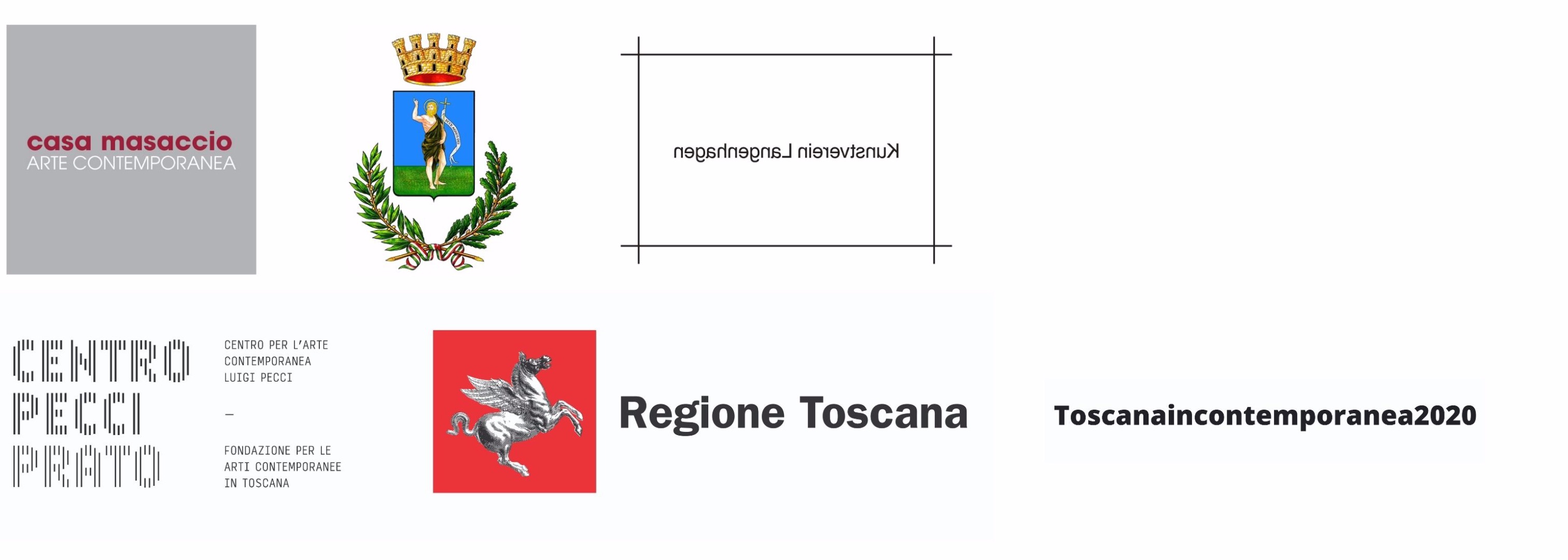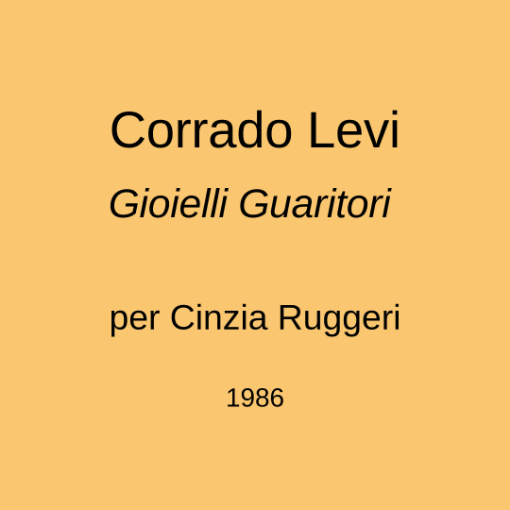EXPANDED REALITY #7 | Corrado Levi: gioielli per Cinzia Ruggeri | Damiano Gullì
Cinzia Ruggeri
…per non restare immobili
a cura di Rita Selvaggio
Corrado Levi
Gioielli guaritori per Cinzia Ruggeri e Gioielli Terzaroli
Damiano Gullì
Nel 1924 al teatro Arena del Sole di Bologna è rappresentata per la prima volta la commedia musicale satirica Gastone di Ettore Petrolini (Roma, 1884-1936), attore, drammaturgo, cantante, sceneggiatore, compositore e scrittore. Protagonista è, appunto, l’attore Gastone con le sue tragicomiche contraddizioni: è istrionico e carismatico, ma recita in varietà di infima categoria. È affabulatore, squattrinato, dedito a mille vizi, oggetto di svariati corteggiamenti. È teatrale nei modi e nelle pose, ma fondamentalmente malinconico e solo. L’abbigliamento di Gastone è elegante, ma al contempo goffo: cilindro, frac, gilet, bastone e un vezzoso mouchoir penzolante dal polso. Prendendo ispirazione da questo personaggio nasce nel 1986 una collezione di gioielli anomali, i Gioielli guaritori per Cinzia Ruggeri, intrisa di humour, realizzata da Corrado Levi – figura eclettica, architetto, artista, intellettuale, agitatore culturale, docente, critico, curatore, collezionista – per Cinzia Ruggeri, suggeritrice del titolo per una sfilata. Documentati dagli scatti di Ilvio Gallo, questi gioielli apotropaici, in cui i confini tra alto e basso, prezioso e banale, si annullano in un colpo, sono messi in scena in una sorta di beckettiano teatro dell’assurdo: quadretti anonimi – comprati da Levi in un mercatino sotto casa – sono inseriti su di una gamba, sotto un vestito o sono disposti a corona sulla testa o, ancora, una serie di posate – tra il minaccioso e il faceto – è appesa ai polsi o popola i taschini dei modelli.
Affini nell’attraversare con elegante nonchalance le discipline, Corrado Levi e Cinzia Ruggeri hanno collaborato in diverse occasioni. Levi, ad esempio, ha selezionato Palla di pelle di pollo della Ruggeri per la seminale mostra Il cangiante, da lui curata al PAC di Milano nel 1986, e, nello stesso anno, l’ha coinvolta con Denis Santachiara in Dopo Gondrand nel suo spazio milanese di corso San Gottardo. Levi inoltre ha allestito nello showroom della stilista un bizzarro corner di caramelle, ben prima di Félix González-Torres.
Del 1987 è la collezione, non realizzata e di cui restano solo schizzi progettuali, Gioielli Terzaroli, sempre di Levi. Anche in questa occasione il nome è dato dalla Ruggeri e prende spunto dal linguaggio della marineria velica antica. Nelle navi medioevali il terzarolo è la vela più alta, ossia la più piccola, in grado di essere attrezzata abbasso per sostituirne una maggiore come vela di fortuna in caso di forte vento. I Gioielli Terzaroli sono quindi gioielli, talvolta effimeri, aperti alla possibilità e al caso. Un caso che si può presentare nello scioglimento al sole del gioiello stesso, fatto di ghiaccio, o nella fatica e impedimento dei movimenti, dovuti a un pallone enorme fissato alla caviglia, o nello svenimento e caduta di un modello durante una sfilata: una serie di gag da agrodolce slapstick comedy per riflettere sulla fallibilità e su limiti e possibilità del progetto.
Damiano Gullì (Fidenza, 1979) vive e lavora a Milano. I suoi ambiti di ricerca sono l’arte contemporanea e il design. Dal 2004 si occupa di comunicazione per Triennale Milano, dove dal 2018 è anche Assistente Curatore del Direttore del Museo del Design Italiano. Del 2020 la curatela, con Joseph Grima, della monografica Corrado Levi. Tra gli spazi in Triennale Milano. Ha curato diverse mostre in Italia e i suoi testi compaiono in cataloghi e pubblicazioni italiane e internazionali. Scrive regolarmente per “Flash Art” e “Artribune”, per la quale ha ideato la rubrica Pittura Lingua Viva. Ha collaborato con le riviste “Inventario”, “Paesaggio Urbano”, “8½”, “MU6” e “Inside Art”.
Progetto realizzato nell’ambito di Toscanaincontemporanea2020
Corrado Levi
Gioielli guaritori per Cinzia Ruggeri and Gioielli Terzaroli
Damiano Gullì
The satirical musical comedy Gastone was performed for the first time at the Teatro Arena del Sole in Bologna in 1924. Written by the actor, playwright, singer, scriptwriter, composer and author Ettore Petrolini (Rome 1884-1936), its lead was in fact the actor Gastone, with all his tragicomic contradictions: he was histrionic and charismatic, but performed in variety theatre of the lowest kind. He was a raconteur, perennially broke, given over to a myriad vices and the object of much courtship. He was theatrical in his manners and his poses, but fundamentally a melancholic and lonely man. Gastone’s attire was elegant, but at the same time gauche: top hat, tails, waistcoat, walking stick and an affected mouchoir dangling from his wrist. In 1986 this personage provided the inspiration for a collection of anomalous jewellery, called the Gioielli guaritori per Cinzia Ruggeri, or ‘Healing Jewellery for Cinzia Ruggeri’. Infused with humour, it was made by Corrado Levi – the eclectic figure of an architect, artist, intellectual, cultural firebrand, teacher, critic, curator and collector – for Cinzia Ruggeri, who had suggested its title for a fashion show. Documented by the photos of Ilvio Gallo, these apotropaic pieces of jewellery, in which the boundaries between high and low, precious and banal, were wiped out at a blow, were presented in a sort of Beckettian theatre of the absurd: anonymous little pictures – bought by Levi at a flea market near his home – were inserted on a leg or under clothing or arranged to form a crown on the head; or again a series of pieces of cutlery – between the threatening and the jocular – were hung from the wrists of the models or thrust into their pockets.
Alike in the way they moved with elegant nonchalance between the disciplines, Corrado Levi and Cinzia Ruggeri collaborated on more than one occasion. Levi, for example, selected Ruggeri’s Palla di pelle di pollo (literally ‘Ball of Chicken Skin’, but actually part of an Italian tongue twister) for the seminal exhibition Il cangiante that he curated at the PAC in Milan in 1986. And the same year he involved her and Denis Santachiara in Dopo Gondrand at his space on Corso San Gottardo in Milan. Levi also installed a bizarre corner of sweets in the fashion designer’s showroom, long before Félix González-Torres.
From 1987 dates the collection Gioielli Terzaroli, never realized and only attested by a few design sketches, again by Levi. On this occasion too it was Ruggeri who came up with the name, taking her cue from the language of the ancient tradition of sail. On mediaeval ships the terzarolo was the topsail, i.e. the smallest one, which could be hoisted to take the place of a larger one and used as a storm sail when the wind was strong. Thus the Gioielli Terzaroli were pieces of jewellery, sometimes of an ephemeral nature, open to possibility and chance. Chance that could present itself in the form of the piece melting in the sun, being made of ice, or of the effort and impediment to movement due to the shackling of an enormous ball to the ankle, or of the fainting and collapse of a model during a show: a series of gags from a wry slapstick comedy intended to make people think about fallibility and the limitations and possibilities of design.
Damiano Gullì (Fidenza, 1979) lives and works in Milan. The areas of his research are contemporary art and design. Since 2004 he has been responsible for communication at the Triennale di Milano, where since 2018 he is also assistant curator to the director of the Museo del Design Italiano. In 2020 he was the curator, with Joseph Grima, of the monographic exhibition Corrado Levi. Tra gli spazi at the Triennale di Milano. He has curated a number of exhibitions in Italy and his writings have appeared in Italian and foreign catalogues and publications. He contributes regularly to Flash Art and Artribune, for which he conceived the column ‘Pittura Lingua Viva’. He has worked with the magazines Inventario, Paesaggio Urbano, 8½, MU6 and Inside Art.
Project carried out as part of the initiative Toscanaincontemporanea2020.

Ringraziamenti / Acknowlegments:
Angus Fiori (Archivio Cinzia Ruggeri, Milano)
Aldo Lanzini
Federico Vavassori e Laura Salvo (Galleria Federico Vavassori, Milano)
Emanuela Campoli (Campoli Presti, Parigi/Londra)
Francesca Pia (Galerie Francesca Pia, Zurigo)
Benedetta Pesci e Michele Stacchini (Poltrona Frau S.p.a.)
Fredi Fischli, Niels Olsen, Valentina Enhimb, gta Exhibitions, ETH Zurigo
Georg Brintrup
Anna Battista
Mariuccia Casadio
Elena Fava
Tiziana Paini
Al fine di poter garantire lo svolgimento etico dell’evento nel rispetto della normativa vigente relativa l’emergenza Covid-19, si richiede la gentile prenotazione per accedere all’opening di sabato 12 settembre e/o per le visite successive.
Fasce orarie:
18.30 – 19.00 | 19.00 – 19.30 | 19.30 – 20.00
I visitatori saranno divisi in gruppi, si prega quindi di indicare l’orario prescelto per la visita attraverso la Vs mail di risposta e prenotazione.
Vi ringraziamo per la Vs collaborazione.
Casa Masaccio Centro per l’Arte Contemporanea
Corso Italia 83, 52027 – San Giovanni Valdarno
Tel. 055 9126283
casamasaccio@comunesgv.it


